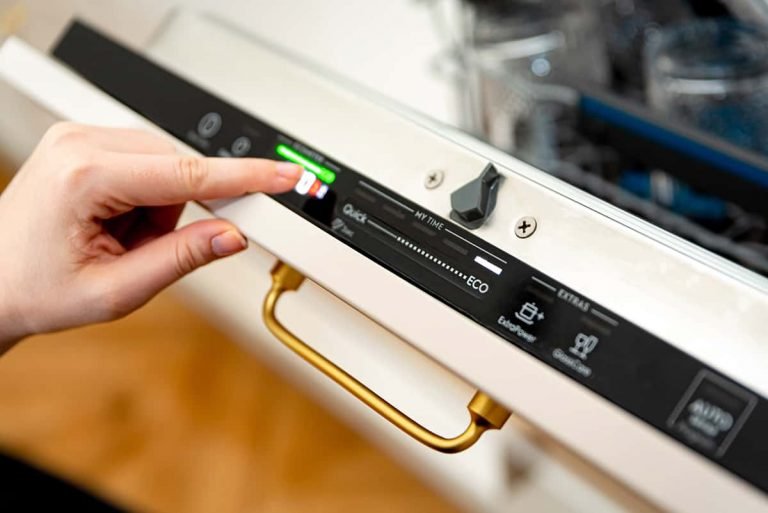
Error codes are little messages from your dishwasher to you. They’re like the appliance’s way of saying, “Hey, something’s not right here!” Specifically, the error code “HE” refers to an issue with the heating element. Imagine the heating element as the kettle inside your dishwasher, responsible for heating the water that ensures your dishes come out sparkling clean. When it hiccups, your dishwasher might stop mid-cycle, leaving you with soggy yet not-so-squeaky-clean dishes. Our mission is to reset your dishwasher to address this issue without needing a degree in engineering or a special appliance dictionary.
Understanding Error Code HE
So, what is this mysterious “HE” error code? Well, as mentioned earlier, it’s all about the heating element. The heating element in your dishwasher is crucial for drying your dishes and for the overall effectiveness of the cleaning process. Think of it as the sun on a sunny day, vital for drying clothes. Similarly, your dishwasher needs a functional heating element to dry and sanitize dishes properly. When the error code “HE” appears, it indicates that something isn’t quite right with this component.
This could be due to a few reasons. Sometimes, it’s simply a minor glitch – like when your computer needs a quick restart to get back to normal. Other times, the error may indicate that there’s a problem with the wiring, or it could mean that the heating element itself has developed a fault. But don’t worry; resetting the dishwasher is often a good first step to take. Resetting is essentially like giving your dishwasher a fresh start, allowing it to recalibrate its settings and hopefully resolve minor issues.
However, if the problem persists or the error code reappears after resetting, it might be time to roll up your sleeves a bit more. We’ll cover troubleshooting steps ahead to help you understand whether it’s a simple fix or if you need to call in a professional. Rest assured, by the end of this guide, you’ll feel more confident in handling this situation.
Steps to Reset Your Whirlpool Dishwasher
First things first, let’s talk about safety. Before you start tinkering with your dishwasher, make sure to unplug it from the electrical outlet. This is crucial to prevent any electrical mishaps. Imagine it’s like taking your phone’s battery out when it’s acting up – only safer because you’re dealing with a large appliance. Once you’ve ensured that the power is disconnected, leave it for a few minutes. This rest period allows the system to cool down and reset itself naturally.
After giving your dishwasher a short nap, plug it back in. It’s time for a manual reboot. You’ll typically start by pressing the “Start/Reset” button on your dishwasher control panel, holding it down for a few seconds until you see the lights flicker or hear a beep. It’s like saying, “Okay, dishwasher, let’s try this again!” Once this is done, and depending on your model, the dishwasher might start a brief cycle as it recalibrates itself.
If everything goes well, your “HE” error code should disappear. However, if it shows up again, don’t fret just yet. It might mean that something deeper needs attention. It’s like when your car engine light won’t go off – sometimes, it’s a minor sensor issue, while other times, it might indicate something more significant. Let’s dive into troubleshooting next, just in case resetting alone doesn’t do the trick.
Troubleshooting Persistent Issues
Alright, so you’ve reset your dishwasher, and the error code still won’t budge. What gives? It’s like hitting a “refresh” button that didn’t quite refresh, so here’s where a bit more investigation helps. Start by checking the continuity of the heating element itself. Use a multimeter set to the resistance (ohm) setting to test this. A healthy heating element should show a specific range of resistance, indicating that electricity can flow through it. If it doesn’t, the element might be faulty, similar to a blown-out light bulb.
Next, inspect the wiring. Connections can sometimes loosen or corrode slightly over time, much like how rust can creep up on an old bike. Look for any visible signs of wear or damage. If you find any, it might be time for a repair or adjustment. In some cases, recalibrating the thermostat could also help. A thermostat acts like a thermostat in your home, regulating the temperature within the dishwasher.
If all else fails and the error persists, consider calling in a professional technician. They have the expertise to diagnose and fix issues that might be out of your comfort zone. Remember, just like calling in a plumber for a persistent leak, sometimes it’s the best route to ensure your appliance is treated right and can continue serving you well for years to come.
Preventative Measures for the Future
Once you’ve got everything up and running again, you might be wondering, “How can I prevent this from happening again?” Great question! Keeping your dishwasher in top-notch condition is like nurturing a garden; a little maintenance every now and then goes a long way. Regularly clean your dishwasher’s filter and ensure that the spray arms are free of obstructions. This ensures that water flows as it should, much like keeping pipes clear so water can run smoothly.
Also, try to avoid overloading your dishwasher. Imagine it like carrying too many bags at once – something’s bound to slip. Overloading can strain the machine and prevent it from functioning optimally. Use only the recommended amount of detergent and ensure that it’s of good quality. Poor-quality detergent can sometimes lead to residue buildup, which might affect other components over time.
Lastly, consider scheduling periodic maintenance checks with a professional. Just as you’d take your car for a tune-up, treating your dishwasher to the same care can prevent more significant issues down the line. By keeping an eye on things now, you can enjoy stress-free dishwashing in the future, avoiding those pesky error codes from ever needing attention again.